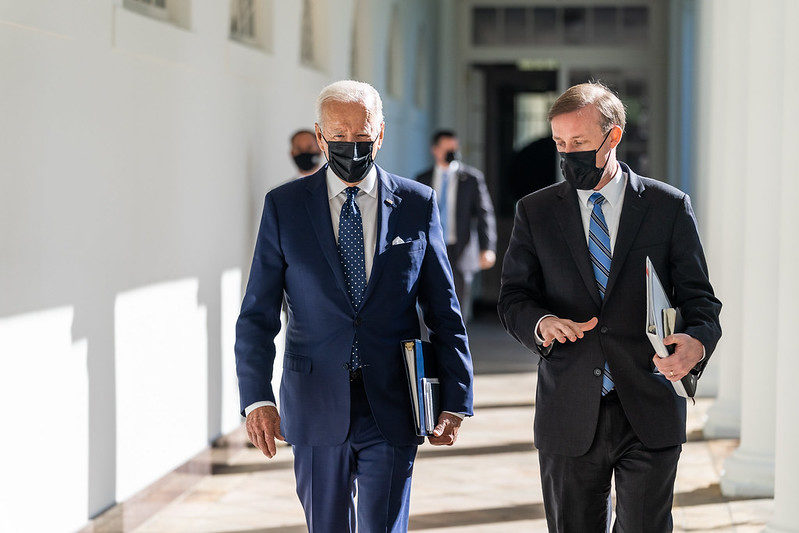This story was updated at 5:32 p.m. Eastern time Feb. 11 to include comments from the NATO official in Brussels.
National Security Adviser Jake Sullivan said based on U.S. intelligence and observations of the buildup of 130,000 Russian troops on three sides of Ukraine that Russian President Vladimir Putin may start an invasion before the Winter Olympics in Beijing end Feb. 20.
Sullivan also stressed that American forces deployed to NATO’s eastern flank are “not going to war with Russia.”
Sullivan spoke from the White House press room for 30 minutes Feb. 11 to describe the “very, very distinct possibility” that war between Russia and Ukraine will begin “any day now” and within a “swift timeframe.”
Later Feb. 11, a NATO official from the eastern flank told Air Force Magazine an invasion as soon as this weekend was a possibility.
“The forces are there,” the official said by phone from Brussels. “They could start executing already this weekend.”
Declassified U.S. intelligence assessments have poured out of the National Security Council in recent months in hopes of deterring Russia from invading Ukraine or from mounting a “false flag” operation as an excuse to invade.
Sullivan said President Joe Biden met earlier Jan. 11, virtually, with the leaders of NATO countries Canada, France, Germany, Italy, Poland, Romania, and the United Kingdom, plus the NATO secretary-general and the president of the European Union.
“We have achieved a remarkable level of unity and purpose from the broad strategy down to the technical details,” Sullivan insisted, noting that Western countries are more united than in many years in their opposition to the Russian aggression and their commitment to impose harmful sanctions on the Russian economy should Putin invade Ukraine.
Sullivan said the coordinated sanctions, should Russia choose to invade Ukraine, would cause a blow to the Russian economy, including its defense industrial base. He also said, should Moscow be coordinating with Beijing, that China would not be able to compensate Russia for the economic suffering that will ensue.
The national security adviser also provided reassurance that the movement of some 3,000 U.S. troops to Romania and Poland—including Air Force squadrons for NATO enhanced air policing and bilateral training with NATO allies on the eastern flank—are going there to reassure allies and not to fight Russia or to defend Ukraine.
“These are not Soldiers who are being sent to go fight Russia in Ukraine. They’re not going to war in Ukraine. They’re not going to war with Russia,” Sullivan said. “They’re going to defend NATO territory consistent with our Article 5 obligation. They are defensive deployments—they are not escalatory. They are meant to reinforce, reassure, and deter aggression against NATO territory.”
Sullivan insisted that Americans need to depart Ukraine “in the next 24 to 48 hours” while commercial options are still available.
At the Pentagon, Chairman of the Joint Chiefs of Staff Army Gen. Mark A. Milley spoke by phone with numerous NATO counterparts, including representatives from Canada, France, Germany, Italy, Poland, Romania, and the United Kingdom. He also called Chair of the NATO Military Committee Adm. Rob Bauer of the Royal Netherlands Navy to discuss adjustments to U.S. force posture in Europe, and he spoke to Russian Chief of the General Staff Gen. Valery Gerasimov, according to a statement from Joint Staff spokesperson Col. Dave Butler.
No detailed readout was provided for Milley’s call with his Russian counterpart.
Milley and the NATO military committee chief discussed NATO’s current operations and coordinating during adjustments to force posture. The calls are consistent with communication Milley has made in recent weeks.
Sullivan, the national security adviser, reported “a credible prospect of a Russian military action [taking] place even before the end of the Olympics.”
“It is likely to begin with aerial bombing and missile attacks that could obviously kill civilians,” Sullivan said. “Communications to arrange a departure could be severed and commercial transit halted. Nobody will be able to count on air or rail or road departures once military action got underway.”
He added that there is “no prospect of a U.S. military evacuation in the event of a Russian invasion.”
The U.S. maintains some 80,000 troops in the European theater during peacetime. Sullivan did not preview any further NATO reinforcement or deterrence measures but said defensive assistance to Ukraine will continue and that 8,500 American troops remain on heightened alert to serve as NATO swift response, if needed.
The NATO official would not confirm whether a decision has been made yet to call up the NATO Swift Response Force, saying only, “Everything is under discussion.”
The United States has in recent weeks delivered ammunition and anti-tank Javelin missiles to Ukraine while the State Department Foreign Military Sales office has fast-tracked third-party transfer licenses, allowing Baltic NATO allies to share short-range air defense systems, including Stinger missiles, with Ukraine.
Despite the grim warning about a Russian invasion, Sullivan insisted that the United States was leaving all diplomatic options open and said President Biden would be open to another telephone conversation with Putin.
